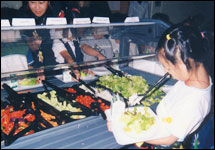MLUI / Articles from 1995 to 2012 / "Lunch Ladies" Search for Local Food
"Lunch Ladies" Search for Local Food
Schools, farmers look for ways to put Michigan products back in the cafeteria
January 30, 2003 | By Patty Cantrell
Great Lakes Bulletin News Service
 | |
| Community Food Security Coalition | |
| Some communities are putting their local farmers and schools in direct contact. Salad bars stocked with fresh produce from nearby farms are spreading in California. In southwest Pennsylvania, farmers are collaborating to supply five area school districts with locally produced and processed beef. |
June Bailey, food service director for Comstock Public Schools near Kalamazoo, knows how she struggles to make sure kids eat fresh, nutritious food. As the wife of a farmer, Ms. Bailey also is familiar with how farmers in Michigan struggle to find buyers for the food they produce.
But rather than buy apples, potatoes, or milk from Michigan’s farms, public schools buy through national food service companies that often supply Washington apples and Texas strawberries instead. Like hospitals and other large food buyers, schools rely on national distributors to deliver large quantities of food, often in preprocessed form, to their doorsteps on a weekly basis.
It bothers Ms. Bailey, however, that more of the food that school children eat does not come from local farms. “We get our carrot sticks from a plant in Kentucky. But I’m told there may be a processor in Grand Rapids that slices carrots,” she says.
“There needs to be a way for farmers to tell me what they have available and for me to tell the farmers what food I need,” she says.
Making the Connection
The good news for June Bailey is that, across the state, another woman with different connections saw the same opportunity.
In Michigan’s highly agricultural Thumb region, Beth Cryderman-Moss witnessed the trouble her farmer friends and neighbors had making money. As a government procurement specialist with Michigan Works!, the state employment agency, Ms. Cryderman-Moss decided to find ways that farmers could land more government food contracts.
In the process, she uncovered a new federal program called the Small Farms/School Meals Initiative. The program puts the U.S. Department of Defense — experts at finding and supplying mass quantities of food — on the job of connecting local schools and local farmers.
From Farm to School
Already showing success in North Carolina, Florida, and Virginia, the Small Farms/School Meals Initiative now is coming to Michigan thanks to Ms. Cryderman-Moss, the Michigan Depart-ment of Agriculture, and the Michigan Department of Education.
“Our plan at this point is to pick one product, pick one area, and do a pilot project,” says Kathy Kissman, MDA’s director of marketing and communications. Lessons learned in the small-scale trial effort will be critical to designing a program that works for those preparing the food, as well as those who grow it, she says.
The program is just in the beginning stages, but its potential in Michigan is tremendous with statewide school lunch expenditures, in 1999-2000, of $400 million per year.
“If you get every school district buying locally grown Michigan apples, that will make a big difference for those farmers,” Ms. Cryderman-Moss says. “And that’s only one farm product.”
What’s Available?
But can Michigan farmers supply the needed variety and volume of food?
Yes indeed, says Ms. Kissman, who points out that the wonders of nature, cold storage, and hydroponics make it possible for even mid-winter menus to feature fresh apples, squash, tomatoes, carrots, beans, herbs, onions, potatoes, eggs, milk, and honey from Michigan.
The key is building awareness and instilling desire, says Marla Moss of the Michigan Department of Education. “We need to generate enthusiasm among the people who will be serving the local asparagus, potatoes, and beans to the kids.”
What Does It Cost?
Schools on always-tight budgets also are sensitive to the price of the food they prepare. The assumption is that mass-market distributors always can sell food for less. But a recent study of farm-to-school food programs shows that is not always the case.
In the national Community Food Security Coalition report Healthy Farms, Healthy Kids, schools in Hartford, Connecticut, found a big difference in some costs. Local apples averaged 8 percent less, while local romaine lettuce was 34 percent less expensive on average.
Contacts: Kathy Kissman, Michigan Department of Agriculture, 517-373-9788, kissmank@michigan.gov; Marla Moss, Michigan Department of Education, 517-241-4054, MossMJ@michigan.gov; Community Food Security Coalition, 310-822-5410, www.foodsecurity.org





